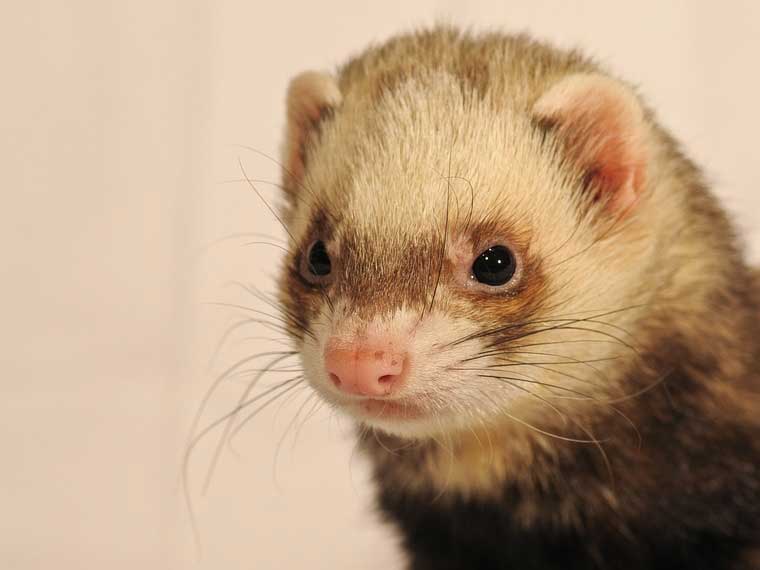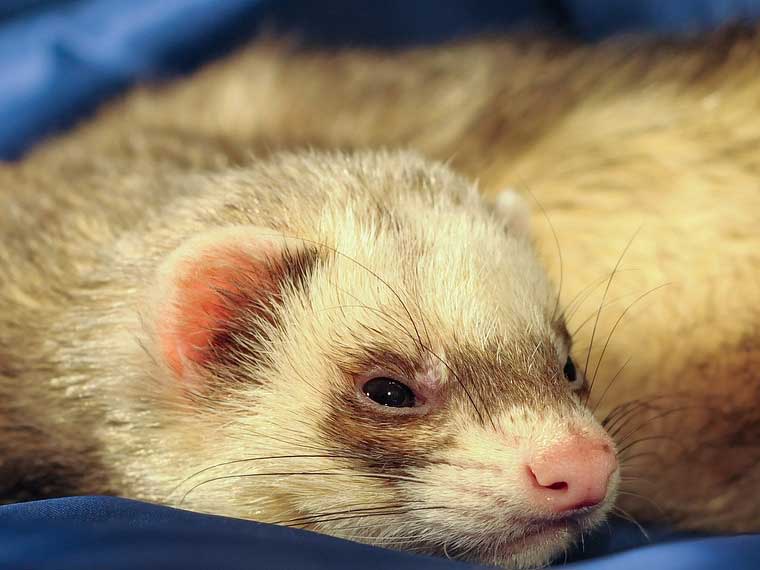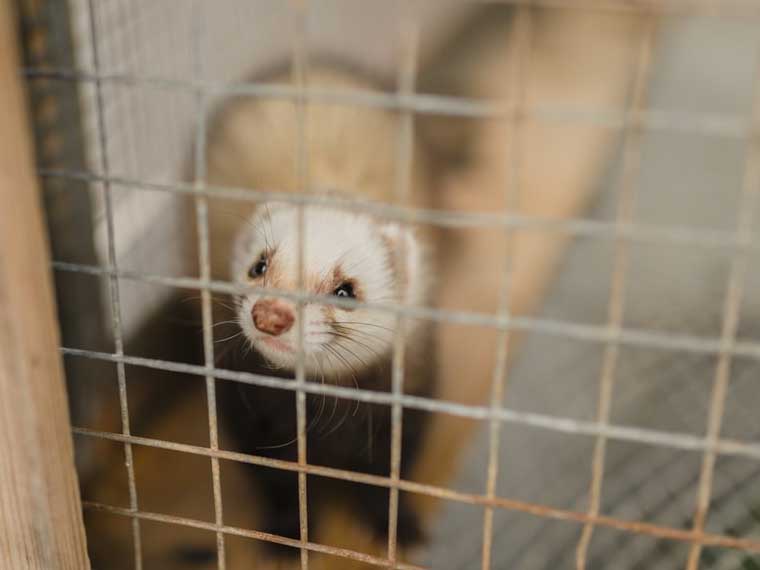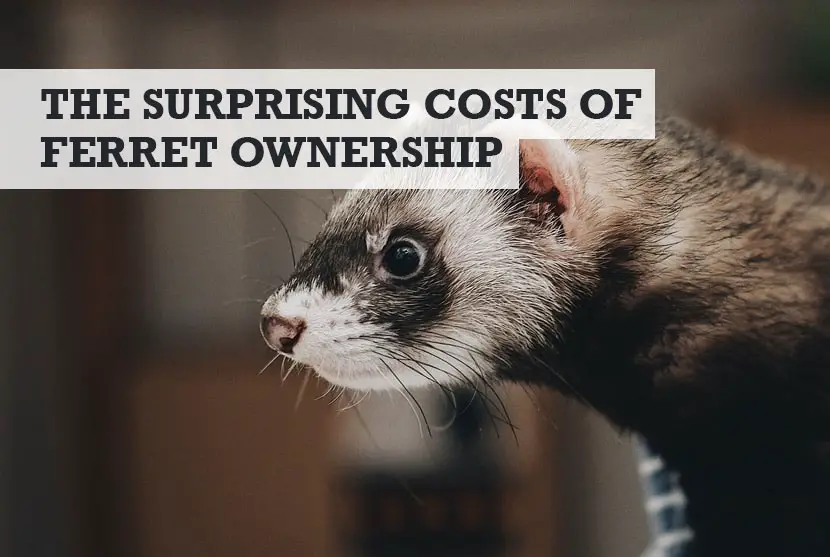Ferrets are cute and cuddly once you have them tamed and trained. However, they do have a reputation for being animals that stink, steal and bite. And surprisingly, they are also considered to be an expensive pet to keep and maintain each month.
In this guide I will explain how much ferrets cost. Not just to buy, also what you can expect to be paying each month and annually should you decide to keep ferrets. You might be surprised at how expensive things can get!
How much do ferrets cost?
There are various costs associated with owning and keeping ferrets. Of course, these costs depend on how much you cut costs or indulge your fur balls. These costs are:
- Buying a ferret costs: free to $400 (£300)
- Set up costs for keeping a ferret: from $400 (£300)
- Annual expenses in keeping a ferret (+ medical costs): $400 to $600 (£300 to £450)
- Contingency costs: Set aside $500 per annum (£370)
Bear in mind that ferrets are sociable animals and prefer to play and bond with other ferrets. You will need at least two ferrets, but preferably a small group of 3 to 4 animals – if you can do that, ferrets make very good pets.
When you consider it like that, the cost of owning a ferret, or ferrets, will quickly accrue. Here’s a more detailed breakdown on how much ferrets cost to buy and keep monthly and annually.

The cost of buying a ferret
There are a number of ways in which you might find yourself the proud owner of a ferret, some will cost more than others.
Find a ferret that is free for rehoming
Ferrets are fluffy and energetic, and consequently are often impulse buys for uninformed would-be pet owners.
Once the truth sinks in that ferrets generally do not tolerate other pets or small children, and the ‘stink, steal and bite’ syndrome becomes a reality, another home is urgently sought – for example, here’s how much a ferret actually stinks!
The owner will be desperate to get the problem off their hands and the ferret or ferrets may be offered for free, most likely with a range of toys, bedding, litter trays, etc.
You might come to hear of such a situation by word of mouth, on Craigslist, or via social media. The more information you can glean about the history of the animal the better.
Handy Hint: Did you know ferrets make a huge range of weird noises? I’ve written a guide to what they all might mean.
Adopt a ferret for a lower buying cost
People who are not able to rehome their ferrets themselves, have the option of surrendering them to specialised small animal shelters. The animals are housed and fed, and checked for health problems. Applications for adoption are screened so the transference of ownership has a better chance of being a success.
The adoption fee for a ferret will range from $150 to $200. This covers the cost of the care of the animal and the screening costs.
The cost of buying a ferret from a breeder
In many countries, states and even cities around the world, ferrets are considered to be wild animals and it is forbidden to keep them as pets. In much of the USA, ferrets are neutered or spayed before they are sold to prevent indiscriminate breeding.
Many breeders remove the ferrets’ anal glands with which they mark their territories, leaving a powerful odour. Others may vaccinate the animals before transferring ownership.
Reputable breeders charge a premium for their ferrets but provide the assurance that you will receive a vetted animal that will have fewer health problems and a longer lifespan. You should be supplied with the full history of your ferret’s health and lineage.
In general terms, ferrets will cost more when bought from a breeder rather than any other route of getting the animal.
Costs vary according to the age and colour of the ferret.
The costs per colour are:
- Sable, Black Sable and Albino ferret: costs between $100-$200
- Champagne and Chocolate ferret: costs between $150 – $300
- Cinnamon ferret: costs up to $400
The cost of a kit, as the young are called, can be up to $200 more than an adult.
You will need to multiply these costs by 2, 3 or even 4 to satisfy the social needs of your ferrets.

The cost of buying a ferret from a pet shop
Ferrets bought at a pet shop may be considerably cheaper than those purchased from a reputable dealer.
However, how much a ferret costs from a pet shop might be less, but you could pay more in the long term. This is because often ferrets bought at pet shops will not come with the health guarantees and a full history a breeder will give.
Ferrets are often sold alongside other small animals, most of which are rodents. Please note that the ferret’s Latin name is Mustela putorius furo, which means ‘stinky weasel thief’ or ‘stinky mouse-eating thief’. They are rodent killers and should not be housed alongside rodent pets.
How much a ferret costs when bought online or by import
Most dealers are not comfortable with selling their ferrets online but if they are, you will be subject to additional shipping and other related costs.
If you are importing a ferret, this could involve microchipping, blood tests, vaccinations, transport, agents’ fees and possibly quarantine costs.
The start-up costs of buying a ferret
Once you have bought a ferret, you will then need to get the gear required, and also “ferret-proof” your home!
Escape-proofing your home
Did I mention that ferrets are notorious escape artists? Before you bring your ferret home you will need to ensure that they do not leave at the earliest opportunity. This will include securing windows and doors in the areas that your ferrets have access to.
Ferrets can mould their bodies to get through inch high gaps and will chew through screen doors. You will need to eliminate all possible exits under doors, through windows, even air vents.
You also need to train all household members and any visitors how to enter and exit your home without letting Houdini out of the house.

Ferret-proofing your house
Ferrets naturally live in burrows. They will want to replicate this habitat in your home, if they are free roaming. They could choose to occupy the innards of your lounge suite or your box spring mattress. They also like to occupy drawers of clothing that smell of their owners.
This tendency could damage to your household goods, or worse still, your ferret. For example, mechanical chairs can be lethal as your ferret could get crushed between the working parts.
Handy Hint: Did you know that it’s not uncommon for some ferrets to have a favorite person?
A safe place to sleep
Ferrets are neither nocturnal nor diurnal, they are crepuscular, which means they are active around dawn and dusk. In the wild, this would be the best time for them to catch their prey. For owners who work, this means that they are playful in the morning before you leave for work, and when you return.
At night and during their daytime sleeping hours, they need somewhere safe and dark to sleep in. There are recommended sizes and layouts for ferret cages. Typically, these would be multi-story so that the ferrets can indulge in climbing exercises during their waking hours.
A blanket or cage cover will be needed to block out daylight and ambient night light.
Ferrets like cuddling up in a dark space when they sleep. If free roaming ferrets find any clothes or a towel lying on the floor or furniture, they will crawl under these for a nap. To prevent stepping or sitting on them, do not leave these items lying around. Provide your ferrets with dedicated fleece blankets or ferret-sized hammocks which can be hung in their cage.
How much it costs to home your ferret
Guide prices for these items described above are as follows:
- Ferret cage: costs $150 to $250
- Cage cover: costs $35
- Fleece blankets: costs $5 each
- Hammocks: costs $15 each
Hygiene costs of ferret maintenance
There are two main causes of the smell associated with ferrets, there scent glands and their protein-infused poo. In many instances, breeders remove their anal glands before you take ownership of your pets. If your ferret is neutered, it will also not feel the need to emit musky pheromones that will identify your home as a ferret den.
It remains for you to potty train your ferrets and to clean their litter box regularly. Ferrets back into a corner to poo and sometimes create a spray effect, which could land on your walls or skirting boards. They do not bury their poo which helps the odour to waft around the room.
If your ferret is fed kibbles, it will need to use the tray about four times a day. On a carnivore diet, it will need to go less often as it is able to thoroughly digest, and derive more benefit from, raw meat.
You will need a tray that is large enough for the ferret to sit in, and preferably one that has a high corner to protect your walls. For training or in lieu of litter, you can use training pads.
It is advisable to place one of these litter trays in each of the rooms that your ferrets roam in, plus one in their cage. This will prevent accidents if they do not have immediate access to a tray.
You will probably find that you need to invest in an air filter (view on Amazon) to help clear the ferret smell from your home. The smell is similar to what you would experience when walking into a home where multiple cats are marking their territory.
You might want to add deodorisers and infusers. Make sure to keep any lit incense out of reach of the ferrets.
Below are approximate retail prices for supplies.
- Litter trays for ferrets cost: $15
- Training pads for ferrets cost: $30 for a hundred
- Litter for ferrets cost: $10 a bag
- Air filter for ferrets cost: $100 – $200
- Deodoriser for ferrets cost: $15
- Infusers for ferrets cost: $5
Costs of ferret feeding apparatus and water points
Ferrets enjoy scratching in their food and splashing in their water which can generate a mess. You will need a bowl with that prevents this. A ferret-friendly combination food and water bowl will cost around $20.
Costs for transporting your ferret
For various reasons, you may want to transport your ferret, for example for a visit to the vet. If you want to take them on walks, you can either strap a harness and leash on their backs or you can transport them in a backpack which has a see through back section.
Both the backpack and the carrier (view on Amazon) can be purchased with side extensions to give your animals more space.
These items’ costs are as follows.
- Carrier: $25-$45
- Backpacks: $40
- Harness and leash: $10 to $20
How much do ferrets cost to maintain each month?
Ferrets were once exclusive to royalty and the clergy. They were employed in castles to catch rodents. An English lady, during Tudor times, might keep one up her sleeve to release every time she saw a mouse.
There is a perception in modern times that they are still require a king’s ransom to acquire and maintain. Although you might find ferrets on Craigslist being advertised free to a good home, they do need specialised care, a customised environment and a finely tuned diet.
How much it costs to keep a ferret each month will soon add up. Ferret maintenance costs
Ferret diet costs each month
Ferrets are often sold in pet shops in the small animal section, alongside rodent pets. One wonders what signals are being sent between the species, because ferrets are in fact carnivores and mortal enemies of rodents.
They are classified as obligate carnivores which means that at least 70% of their diet needs to be meat. Their teeth and digestion system are designed for the tearing and processing of meat. They cannot tolerate fruit, vegetables or grains in their diet.
Ferret pellets / kibble costs
There are various feed pellets on the market for ferrets but care needs to be taken that these are indeed free of the ingredients that could harm their health. Seek advice from your vet or breeder on the best products to buy.
If you do feed your ferrets kibble, they will need to have access to plenty of water to smooth the digestion of the dry blocks. Kibble also increases the number of times they use their litter trays. Their bodies are much more efficient at digesting meat than pellets.
Feeding ferret raw meat costs
In order to simulate their natural diet, raw meat is the optimum food source. Ferrets consume approximately 4 ounces a day each so this should not break the bank. Many owners have found that if they shop around, buy in bulk, opt for cheaper cuts, and freeze the meat, the costs are comparable with a kibble diet.
If your ferret would normally eat rodent meat, it probably would not be worth ‘spoiling’ it with a fillet steak. The difference, of course, is that the raw meat diet will require considerably more time, planning and effort.

Ferret supplements costs each month
In order to compensate for any vitamins or minerals missing from your ferret’s diet, it is recommended that they be given supplements, much like we would take multivitamins.
The costs per month are:
How much a ferret costs each month to keep
- Ferret kibble each month costs: $20 a month (annual $240)
- Ferret raw meat diet each month costs: $20 to $70 a month (annual $240 to $840)
- Ferret supplements each month costs: $5 a month (annual $60)
Health Care costs
Unfortunately, many ferrets do not have a good start in life. They may be the product of a breeding mill, or they may have been rehomed a couple of times. Animals with this sort of history, tend to have shorter life spans.
Pet health care insurance is probably an expense that you should consider budgeting for because the chances are high that your ferret will need expensive health care sometime in the future.
Alternatively, or perhaps in addition to your insurance plan, you should consider accumulating an emergency surgery fund.
- Ferret health care insurance costs: $25 per month (annual $300)
- Ferret emergency surgery fund costs: $500
Spaying, neutering and gland removal costs
If you purchase your ferrets from a reputable dealer, it should come with a full genealogy and list of possible health issues. In the USA, most ferrets are desexed before they are sold, and many have their anal scent glands removed. Thankfully, this is not an annual cost
Ferret vaccination costs
Domesticated ferrets are prone to a number of diseases and ailments. They need to be vaccinated against distemper, a fatal disease that is highly contagious.
The first vaccination should be given after 12 weeks of age, and may be administered by the breeder before you take possession of your ferret. Boosters are needed every 1 to 3 years.
Depending on the area in which you live, your ferret may need an annual rabies shots. As rabies is a zoonotic disease that readily transmits to human beings, many state veterinarian departments offer the vaccination for free.
It is prudent to have a health check-up while your ferret is receiving its regular jabs. This could preempt any latent or underlying problems.
- Ferret vaccination costs: $100
- Annual check-up vet costs: $50
The possible health issues that could mean your ferret costs more to keep than you would otherwise expect include:
Problems associated with glands and hormones
Ferrets often develop adrenal disease because their reproductive and anal glands are removed at a very young age. Symptoms include irritability, skin problems and hair loss.
Possibly for the same underlying reason, ferrets develop enlarged lymph nodes that, if undetected, can become cancerous. This is known as lymphoma.
The flip side of this problem is aplastic anemia, which occurs if females are not spayed and not given the opportunity to mate. Female ferrets need to mate in order to stop the production of estrogen. This hormone suppresses the production of bone marrow cells and consequently causes a shortage of red blood cells.
Pancreas and insulin production
Ferrets do not have the metabolism necessary to digest sugars and starches. They can develop a condition known as Ferret Insulinoma, which is the opposite of diabetes experienced in humans. It is caused by an overactive pancreas which produces too much insulin for the body’s needs and results in a drop in glucose and blood sugar levels.
Your ferret will either need to be on regular medication or have part of its pancreas removed.
Intestinal obstructions
This is another common problem associated with keeping ferrets. They enjoy chewing pliable substances, especially plastic and rubber. Often they inadvertently swallow these and end up with an object stuck in their gut.
This prevents any food or waste to pass through their digestive tract, and results in constipation, possibly septicemia, and even death. Surgery is required to fix the problem.
Hairballs can cause similar problems as hair is not digested. It can accumulate and form a blockage which needs to be removed.
Below are some costs that you may incur if your ferret requires surgery:
- Emergency examinations cost: $90
- Ferret X-rays cost: $120
- Laboratory fees (for blood and other tests): $100
- Surgery costs: unknown
Dental hygiene costs in ferrets
Ferrets have teeth like canines, which can attract plaque build-up and gum disease. A regular visit to the vet will pick this up and be able to ward off any dental problems. Costs can rise according to the dental work that needs to be done.
- Ferret’s dental clean-up costs: up to $475
Toiletry costs
Ferrets are descendants of polecats and have a similar reputation when it comes to smell. They emit a musky odour in general and smelly poops, in particular. If they eat a raw meat diet, this is mitigated to some extent by fewer daily deposits in the litter tray.
Nevertheless, you are going to need ferret grade litter or puppy training pads (view on Amazon) to be regular items on your shopping list. Deodorisers and infusers might also be a thought.
- Training pads for ferrets cost: $30 for a hundred
- Ferret toilet litter costs: $10 a bag
- Deodoriser costs: $15
- Infusers cost: $5
Other contingency costs to consider
If you own a ferret, you may want to consider adding public liability and all risks to your regular insurance contract costs.
If they think they are in danger, ferrets will scratch, nip or bite. These injuries will definitely leave a scar but a bite may also lead to infection. No doubt the experience will sour relationships with visitors and guests, and you may find yourself being sued for damages.
It is not advisable to keep ferrets in a home where there are young children or other pets.
The other evil trait that ferrets have is that they steal. Their name means ‘thief’! One of their super powers is to hide things away in places where you will never find them.
They particularly like shiny objects, so your watch, rings, and other items of jewellery are fair game. They are also partial to soft rubber items such as erasers, latex gloves, balloons, and the keys off your remote.
These may cause the aforementioned surgery bills to mount up.
Conclusion
Believe it or not, ferrets used to be exclusive to nobility and the clergy in England. Not so much in modern times though.
Now they have become a more common pet, but they do come with their challenges as you can see from the links below.
There are also hidden costs in owning ferrets, so please do think carefully before buying one. You will need to spend money to maintain and keep your ferrets healthy and happy.
You might also like…
- This is how bad your ferret will stink out the house unless you take precautions
- How often you should bathe your ferret
- How long a ferret can go without eating
Image in header via https://unsplash.com/photos/FnpFMheGjH0




